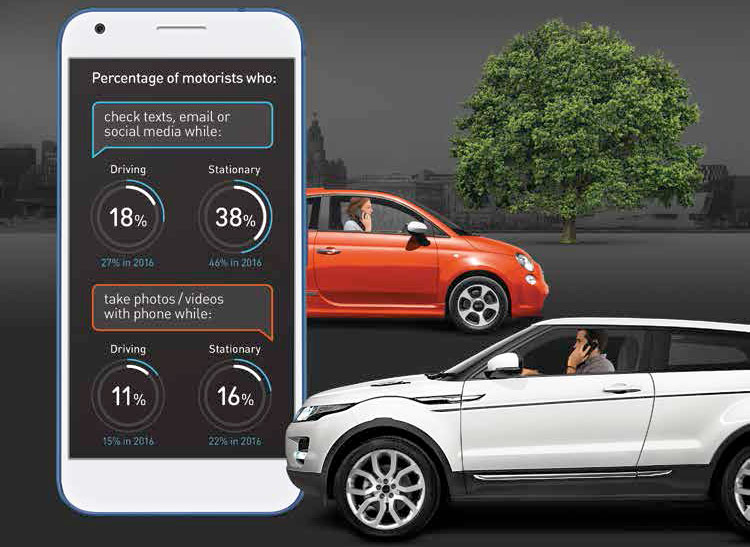Nine million motorists refuse to put down their phones while driving
Numbers down on 2016 but "hard core" remain immune to tougher penalties
A REPORT by motoring group the RAC suggests more than 9m motorists in the UK use a handheld phone to make or receive a call while driving, six months after the penalties for doing so were doubled to six points and a £200 fine.
Some 23% of the 1,727 motorists questioned for the RAC’s Report on Motoring 2017 admitted to having used a handheld mobile at the wheel to make or take a call in the past 12 months, equating to 9.2m drivers.
In addition, 18% (7.2m) admitted to checking texts, emails of social media, while 13% (5.2m) said they even composed text messages, emails or social media posts while driving. Those who admitted to taking photos or filming videos via a handheld phone made up 11% (4.4m) of those surveyed.
Browse NEW or USED cars for sale
The figures represent a 28.7% year-on-year reduction in handheld phone use while driving, suggesting the Government’s tougher stance has had some impact. Only 11% of motorists claim to be unaware that the law has changed, and of the 89% who are aware, 28% say they have modified their own behaviour as a result.

However, the RAC says there remains a hard core of regular users who do not recognise – or do not care about – the danger that their own handheld mobile use causes.
RAC road safety spokesman Pete Williams said: “Twelve months ago our research revealed that the illegal use of handheld mobile phones by drivers was at epidemic proportions – a year on and the situation still remains dire.”
“Drivers of cars with stop-start engines sometimes have the perception that they are not breaking the law because their engine is off”
Citing a Freedom of Information request by the Press Association showing overall roads policing officer numbers in England and Wales fell 30% between 2007 and 2016, from 3,766 to 2,643, Williams added:
“It is clear we have a hard core of persistent offenders who believe they can get away with it by continuing to flout the law every day and we fear this may get worse with fewer dedicated roads policing officers.”

A larger number of people have used a handheld phone while stationary in traffic, according to the RAC figures. Forty per cent (15.9m) of motorists owned up to talking on their phone when stationary in traffic, down from 48% in 2016, while nearly a third (29% or 11m) have written texts, emails or social posts when waiting to move.
Suzette Davenport, Former Chief Constable, Gloucestershire Police, and National Lead for Roads Policing in England and Wales, said: “Motorists are still using their phones while stopped in traffic or at lights, even though this is also illegal. One issue here is that drivers of cars with stop-start engines sometimes have the perception that they are not breaking the law by doing so because their engine is off.”
Those who use their cars for work are more likely to use handheld phones, according to the study: 26% of business drivers say they either rarely or sometimes make calls in this way, compared with 18% overall.
Women are less likely than men to answer incoming calls on a handheld phone while driving: 57% of female motorists would ignore the call compared with 43% of men.
Browse NEW or USED cars for sale
Drivers justified their actions with excuses that varied from the concerning, such as “It was an emergency” (18%) and “I needed information for my journey” (17%), to the shocking “I’m in the habit of doing so” (12%), “I can get away with it” (10%), “I didn’t realise it was illegal” (9%) and “Everyone else does it” (5%).
The RAC launched its Be Phone Smart campaign in March 2017 in an attempt to encourage drivers to kick their handheld mobile phone habit. The organisation says its Report on Motoring 2017 was carried out by Quadrangle in May and involved a sample of 1,727 UK motorists, was nationally representative of age, gender, socio-economic groups, all UK regions, and car ownership (company car drivers vs. private car owners).
Handheld mobile phone use by activity when driving
| Activity (admitted) | 2016 | 2017 | Difference | 2017 numbers |
| Making or receiving a call | 31% | 23% | -25.8% | 9.2m |
| Checking texts, emails or social media | 26% | 18% | -30.8% | 7.2m |
| Texting, emailing or posting to social media | 19% | 13% | -31.6% | 5.2m |
| Taking photos or videos | 15% | 11% | -26.6% | 4.4m |
| Total average reduction for all handheld mobile phone use in the last 12 months when driving | -28.7% |
Handheld mobile phone use when stationary in traffic
| Activity (admitted) | 2016 | 2017 | Difference | 2017 numbers |
| Making or receiving a call | 48% | 40% | -16.6% | 16m |
| Checking texts, emails or social media | 46% | 39% | -15.2% | 15.6m |
| Texting, emailing or posting to social media | 37% | 29% | -21.6% | 11.6m |
| Taking photos or videos | 22% | 16% | -27.3% | 6.4m |
| Total average reduction for all handheld mobile phone use in the last 12 months when stationary in traffic | -20.1% |





